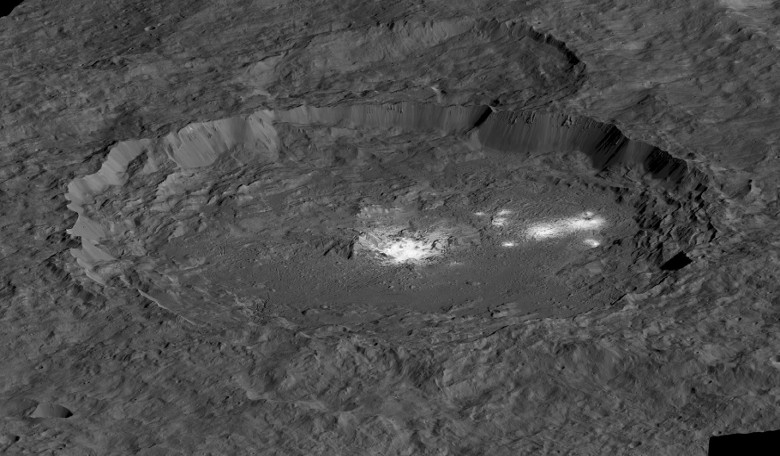Since the arrival of the Dawn mission around dwarf planet Ceres, scientists have been intrigued by a number of bright, reflective spots lighting up crater floors on this small rocky body. Now, after intense scrutiny, scientists say that the bright patches are the product of an active, evolving world.
Just over ten years ago, NASA's Dawn spacecraft set sail for a closer look at the two most massive bodies in the main asteroid belt between Mars and Jupiter: giant asteroid Vesta and dwarf planet Ceres. This truly interplanetary spaceship first explored the giant protoplanet Vesta in 2011-2012, and has been in orbit around Ceres since 2015. This makes Dawn the only spacecraft ever to orbit two destinations beyond Earth (and not merely visit or flyby) and the only craft to orbit an object in the debris-strewn asteroid belt.
Ceres is a world of both rock and ice. With a dark, rigid protective crust, a less rigid interior, and a solid core, Ceres’ lower density hints that ice could make up a major part of its composition beneath the surface. Consequently, the planet has been compared with some of the ice moons of the outer Solar System.
Ceres was reclassified as a dwarf planet in 2006 due to its massive size and since Dawn’s arrival, scientists have located more than 300 bright areas on its surface. However a new study led by Nathan Stein, a doctoral researcher at Caltech in Pasadena, California, suggests that these regions of unusual brightness can be associated with different geological activity and can therefore be divided into four categories.
The first category of material includes the most prominent bright areas found on the crater floors on Ceres and one of the most iconic examples is in Occator Crater. In the centre of the crater, is a region known as Cerealia Facula, which consists of bright material covering a 10 kilometer-wide (6 mile-wide) pit. To the east, is a collection of slightly less reflective and more diffuse features called Vinalia Faculae. These patches that would resemble dirty snow to the human eye, are made-up of salt-rich material, that was likely once mixed in water
"Previous research has shown that the bright material is made of salts, and we think subsurface fluid activity transported it to the surface to form some of the bright spots," Stein said.
The leading explanation for what happened at Occator is that it could have had, at least in the recent past, a reservoir of salty water beneath it. At some point, a large body slammed into Ceres creating the 92 kilometre-wide (57 mile-wide) crater, leaving behind a fractured surface. The upsurge of briny water driven to the surface by a small amount of gas such as water vapour, methane or ammonia – in the the way champagne gushes out of its bottle when the cork is removed – boiled off due to Cere’s lower surface pressure, creating the diffuse bright regions at Vanilla Faculae.
The central dome itself (Cerealia Facula) is thought to have formed from the swelling of icy lava that seeped up in the same impact, causing the area to be uplifted in respect to the rest of the crater. Intermittent phases of boiling may have then occurred during this process, scattering the surface with salt and ice particles that formed the Cerealia bright spot.
A second class of material, but this time found on the rims of craters streaking down toward the floors, is suggested to have formed from impacting bodies that have exposed bright material that was already in the subsurface. Either that or it had formed in a previous impact event.
In the third category, bright material can be found in the material ejected when craters were formed, whereas in the fourth category, this relates to the one instance on Ceres where bright material is unaffiliated with any impact crater. This category contains the mountain Ahuna Mons – a likely cryovolcano that formed by the gradual accumulation of thick, slowly flowing icy materials that now marks its flanks with prominent bright streaks.
"The mysterious bright spots on Ceres, which have captivated both the Dawn science team and the public, reveal evidence of Ceres' past subsurface ocean, and indicate that, far from being a dead world, Ceres is surprisingly active. Geological processes created these bright areas and may still be changing the face of Ceres today," said Carol Raymond, deputy principal investigator of the Dawn mission.
Dawn is still actively studying Ceres and it is set to descend to less than 200 kilometres (120 miles) from its surface at closest approach in the final phase of its mission. When that happens, scientists will hopefully be able to analyse the origins of the bright material on Ceres like never before and find out what gives rise to the enigmatic features in Occator.











